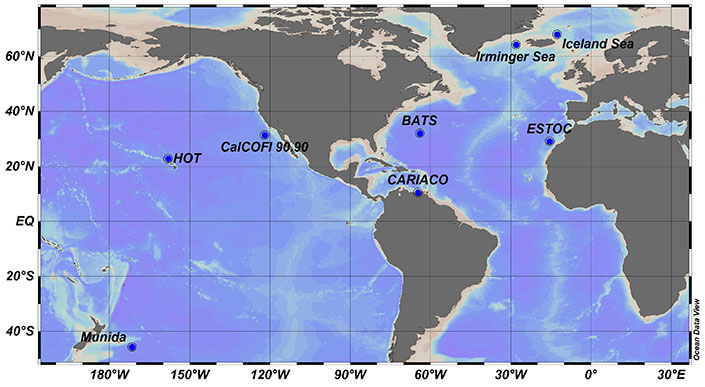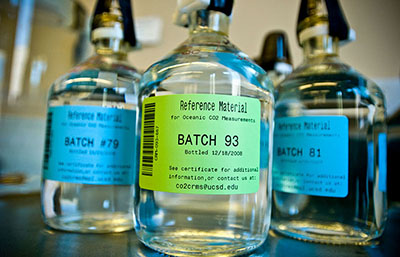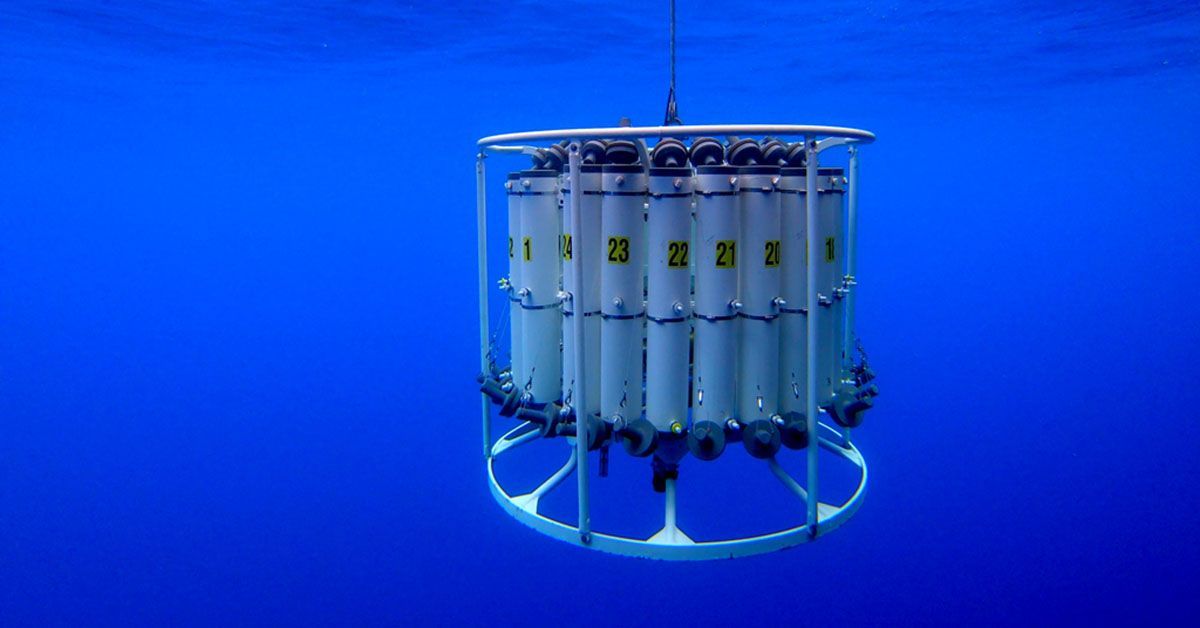Scientists Publish 37-Year Record of Ocean Acidification off Southern California
The longest ocean time series of dissolved carbon dioxide in the Pacific — part of the “Keeling Curve of the ocean” — is revealed
Story by:
Published Date
Story by:
Topics covered:
Share This:
Article Content
For the first time, scientists at UC San Diego’s Scripps Institution of Oceanography have published nearly four decades’ worth of dissolved carbon dioxide measurements from waters off Southern California. The measurements reveal a slight but consistent trend of ocean acidification, a process characterized by a decrease in the ocean’s pH over time due to its absorption of carbon dioxide (CO2) from the atmosphere.
Since the early 1980s, samples of ocean carbonate chemistry have been collected by the California Cooperative Oceanic Fisheries Investigations (CalCOFI) program, which was established in 1949 to investigate the collapse of the sardine population off California. In a new study, Scripps Oceanography researchers present 37 years of measurements from CalCOFI Line 90 Station 90 (station 90.90), a measuring site located 450 kilometers (280 miles) off the coast of San Diego. The team’s findings were published on Nov. 3 in Communications Earth & Environment, a journal affiliated with Nature.
The measurements from station 90.90 establish the oldest time series of direct inorganic carbon observations in the Pacific Ocean. While measurements at the station carry on to the present day, the study details quarterly measurements collected from 1984 to 2021, with a gap from 2002 to 2008 due to a lack of funding. Notably, the data show that the seawater at the study site is getting more acidic, with a measured decrease in pH of 0.0015 per year.
“We’re tracking a climate signal in a spot in the ocean where we really have never seen those measurements published before,” said Scripps Oceanography marine chemist Todd Martz, one of the lead authors on the paper. “Fewer than 10 places in the world have time series that are similar in length, which underscores the significance of publishing these findings.”
Ocean acidification is a global concern due to its adverse effects on calcifying organisms, such as corals and shelled creatures. As waters become more acidic, these organisms face difficulties in building their shells or coral structures, and scientists are concerned about the potential impacts across the marine ecosystem.
The multi-decade research effort to track ocean acidity levels began thanks to Charles David Keeling, a pioneering Scripps Oceanography geochemist who is renowned for his work establishing the Keeling Curve — a daily record of global atmospheric CO2 concentration. In 1983, Keeling initiated CO2 measurements on seawater bottles collected by the CalCOFI program and played a key role in establishing the dissolved CO2 measurements at two other hydrographic stations near Bermuda (BATS) and Hawaii (HOT), which also continue to this day.
As the ocean time series shows a similar trend of rising CO2 levels, it has come to be known as “the Keeling Curve of the ocean,” encompassing eight stations in total.
“The Keeling Curve of the ocean has been measured and reported by other programs around the globe, but station 90.90, which is among the oldest of the stations and right here in our backyard, has never been published — until now,” said Martz.
Wiley Wolfe, a lead author of the study and recent PhD graduate of Scripps Oceanography, took on the task of analyzing a backlog of samples, data mining to recover all past measurements, and consolidating all the data to illustrate the observed trend.
“It’s been really exciting to turn a room full of bottles into a tool for some scientific discovery,” said Wolfe, now a postdoctoral scholar at the University of Virginia. “This is a fascinating data set, and it just needed somebody to put in the time to complete the analysis and bring it to light.”
Wolfe helped carry the project over the finish line, but noted that he was much like the last runner in a very long relay race that was started by Keeling. The success of the project is greatly attributed to the efforts of numerous CalCOFI crew members, seagoing scientists, and lab technicians who have diligently maintained measurements at station 90.90 over the years.


Scripps Oceanography marine chemist Andrew Dickson, a co-author of the study, has also been integral to the project. In the early days, he collaborated closely with Keeling to develop a standardized system for carbon dioxide measurements in the ocean. The meticulous process involves collecting seawater samples at specific depths, employing a sterilization method to prevent contamination, and adhering to best practices for sealing and storing the bottles as they await analysis in the lab.
Following Keeling’s passing in 2005, Dickson’s lab assumed responsibility for overseeing and analyzing the measurements at station 90.90. Longtime Scripps Oceanography researcher Guy Emanuele has played a key role in the analysis, as well as in other seawater sampling efforts led by the Dickson Lab for the broader ocean science community.
With data from station 90.90 now publicly available, the authors hope it can aid the research community in improving regional models and data products that aim to track carbon within the ocean and the flux of CO2 across the air-sea interface.
The study authors noted that direct measurements of long-term trends in the ocean are rare, due to the difficulty of separating the trend signal from the environmental noise. Establishing a trend may require years or even decades of time in order to “see” the trend emerge in the data.
“Establishing baselines is important, even if they are not immediately newsworthy. Much of oceanography and science is built upon these long-term records, because without them, we can’t know if something has changed,” said Wolfe. “We have to know what the past looks like to know that the present is different — and to make predictions about the future.”
In addition to Martz, Wolfe, and Dickson, the study was co-authored by Scripps Oceanography scientists Ralf Goericke and Mark Ohman.
Measurements for the study were supported by a variety of funding sources including the National Science Foundation (California Current Ecosystem Long Term Ecological Research, award OCE-16-37632), the NOAA Climate Program Office, and currently through the NOAA Ocean Acidification Program.
Learn more about research and education at UC San Diego in: Climate Change
Topics covered:
Share This:
Stay in the Know
Keep up with all the latest from UC San Diego. Subscribe to the newsletter today.




